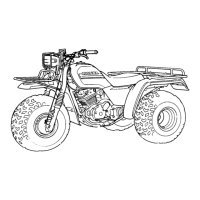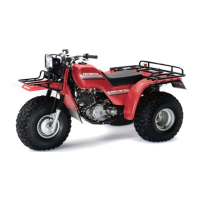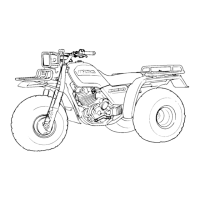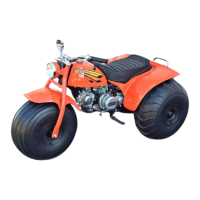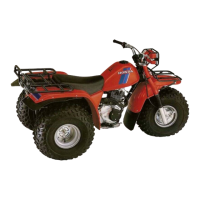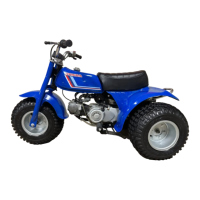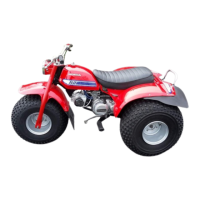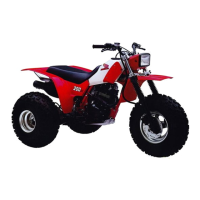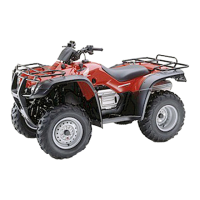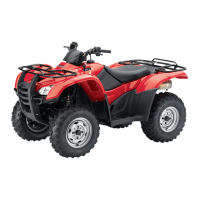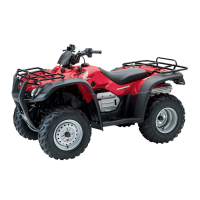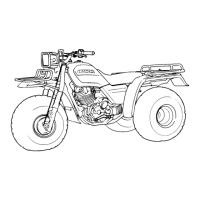
Do you have a question about the Honda ATC Super Red 250 1985 and is the answer not in the manual?
| Brand | Honda |
|---|---|
| Model | ATC Super Red 250 1985 |
| Category | Offroad Vehicle |
| Language | English |
Vehicle is designed for operator only. No passengers allowed due to safety configuration.
Vehicle is designed and manufactured solely for off-road use.
Pay attention to WARNING, CAUTION, and NOTE statements for safety.
Guidelines for safe operation, obeying laws, and riding cautiously.
Recommends wearing helmets, face shields, gloves, boots, and protective clothing.
Modifying the ATC or removing original equipment may render it unsafe or illegal.
Details on maximum load for carriers, storage, and trailer towing weight.
Identifies key external components of the ATC with numbered labels.
Explains the function of the ignition switch and key removal positions.
Details the operation of the starter button to crank the engine.
Explains the function of the three-position engine stop switch.
Explains the ON/OFF positions of the headlight switch.
Describes how to select high/low beams and sound the horn.
Describes the function of the neutral indicator lamp.
Describes the function of the reverse indicator lamp.
Details the steering lock and helmet holder usage.
Explains the usage of the storage compartment and manual compartment.
Explains the operation of the throttle lever.
Describes the function and operation of the choke lever.
Describes the left brake lever and its parking brake feature.
Explains how to use the gearshift pedal for upshifting and downshifting.
Details how to engage reverse gear.
Explains the function and limitations of the 12V DC power receptacle.
Instructions for connecting accessories to the 12V DC receptacle.
Instructions for removing and reinstalling the headlight for night work.
Information on main and other fuses, and warnings about using correct ratings.
Steps to open the rear fender for access.
Explains the five adjustment positions for the rear shock absorber.
Details the function of the three-way fuel valve (OFF, ON, RES).
Information on fuel tank capacity, cap operation, and vent lever.
Step-by-step guide to check the engine oil level using the dipstick.
Specifies recommended oil type and viscosity based on temperature.
Details recommended tire pressure, size, brand, and circumference.
Discusses temporary tire repair using plug kits and carrying repair tools.
Instructions for battery maintenance, storage, and safety precautions.
Daily inspection items to ensure safety and prevent damage before riding.
Steps required before starting the engine, including brake and lever settings.
Detailed steps for starting the engine in normal air temperatures.
Instructions for starting the engine in high air temperatures.
Instructions for starting the engine in low air temperatures.
Procedures for kickstarting and dealing with a flooded engine.
Guidance on how to break in the engine for longevity and performance.
Covers initial riding practice, selecting safe areas, and shifting gears.
Instructions for practicing and safely operating the ATC in reverse.
Explains techniques for negotiating turns, including body weight transfer.
Advice on managing skids and riding on slippery surfaces.
Guidance on safe hill climbing, including weight transfer and throttle control.
Techniques for safely descending hills, including gear selection and braking.
Precautions and procedures for riding the ATC through water.
How to ride across slopes, maintaining balance and avoiding hazardous terrain.
How high altitudes affect air-fuel mixture, performance, and fuel consumption.
Steps to properly park the ATC, including brake engagement and incline parking.
Outlines routine maintenance tasks and their recommended service periods.
Lists the tools provided with the ATC for routine maintenance and simple repairs.
Step-by-step instructions for draining oil and replacing the oil filter.
Instructions for cleaning the fuel strainer to ensure proper fuel flow.
Procedures for cleaning and oiling the air cleaner element.
Explains how to check valve clearance when the engine is cold.
Instructions for adjusting the clutch to ensure proper operation.
How to measure and adjust the free play of the front brake lever.
How to measure and adjust the free play of the rear brake pedal.
Details adjustment for the rear brake lever and its parking brake feature.
Instructions for adjusting the throttle cable free play for smooth operation.
Procedures for draining and refilling the final drive oil.
Steps to take for long-term storage to prevent deterioration.
Steps required to prepare the ATC after a period of storage.
Steps to take before transporting, including draining fuel and disconnecting the battery.
Detailed steps for removing and reinstalling the front wheel.
Procedures for removing and reinstalling the rear wheels.
Lists overall dimensions, weight, and fluid capacities.
Provides a schematic of the ATC's electrical system, including switches and components.
